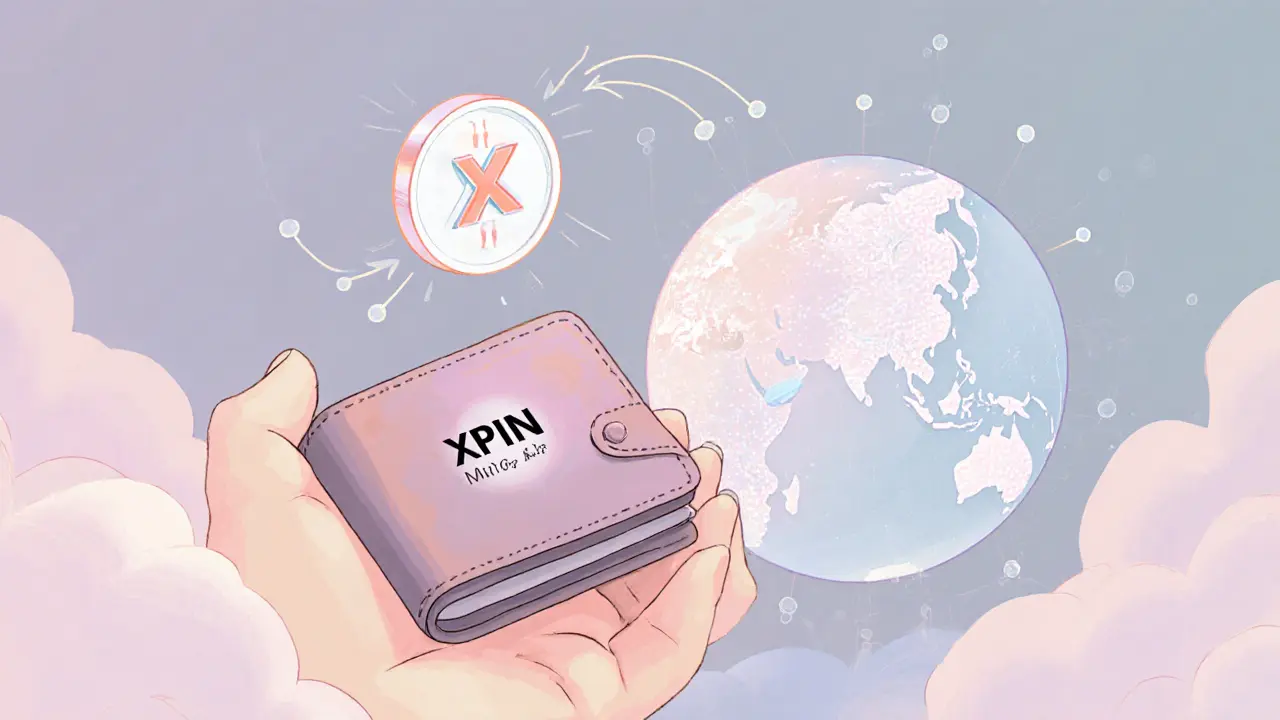XPIN Network (XPIN) Crypto Coin Explained - How It Works & Token Details

Roaming Cost Comparison Calculator
Compare Your Travel Costs
Calculate how much you'd save using XPIN Network versus traditional roaming services based on your travel details.
Imagine traveling from Sydney to Singapore and never having to hunt for a local SIM, worry about roaming fees, or trust a single telecom giant with your data. That’s the problem XPIN Network tries to solve with a blockchain‑powered, AI‑enhanced wireless layer that spans hundreds of countries.
XPIN Network is a decentralized communication infrastructure built on the DePIN (Decentralized Physical Infrastructure Network) model, combining wireless hardware, eSIM technology, and an AI agent called Xtella.AI to deliver global data connectivity. In simple terms, it lets anyone with an internet‑enabled device tap into a worldwide mesh of local operators without relying on traditional carriers.
How the Decentralized Wireless Layer Works
The backbone of XPIN Network is its DePIN architecture. Instead of a handful of corporations owning towers and spectrum, the network distributes those assets across a community of participants who run small base stations or share existing infrastructure. Each node uploads its capacity to the blockchain, where smart contracts verify availability and reward contributors with XPIN tokens.
Two pieces make the system functional:
- Wireless hardware layer: Physical nodes broadcast standard LTE/5G signals that any eSIM‑compatible device can latch onto.
- Blockchain coordination layer: A set of smart contracts governs access rights, pricing, and rewards, ensuring the network remains open and tamper‑proof.
Because the ledger records every connection, users can see exactly which node served their traffic, which boosts transparency and reduces the risk of hidden fees.
Key Products You’ll Use Daily
XPIN offers three consumer‑facing products that turn the decentralized mesh into a plug‑and‑play experience.
- Global eSIM: A digital SIM profile that lives in your phone or IoT device. Once activated, it automatically selects the best local node as you cross borders. No physical SIM swap required.
- XPIN PowerLink: Portable Wi‑Fi hotspots that connect to nearby mesh nodes, turning any space into a high‑speed hotspot without a traditional ISP.
- Universal Dynamic Billing: Prices adapt to the user’s location, so you pay local rates instead of pricey roaming fees. The system displays the cost before you connect, so surprise bills stay a thing of the past.
Data plans are flexible. You can buy a one‑time data package called “Permanent GB,” grab a short‑term “Daily Unlimited,” or commit to a “Monthly Unlimited” plan if you need ongoing coverage.
The XPIN Token and Its Role in the Ecosystem
XPIN token is the native cryptocurrency that powers the network, incentivizes node operators, and fuels the AI‑driven yield‑bearing system. As of October 16, 2025, the token trades around $0.003564 USD on major tracking sites like CoinMarketCap.
Token holders interact with the network in three main ways:
- Staking for rewards: Lock XPIN in the protocol to earn a share of the transaction fees generated by data usage.
- Mining via Xtella.AI: The AI agent creates dynamic NFTs that represent mining rights. Owning one of these NFTs gives you a portion of the mining output.
- Paying for connectivity: When you consume data, the network automatically deducts the appropriate amount of XPIN from your wallet based on the Universal Dynamic Billing rates.

Xtella.AI - The World’s First Yield‑Bearing AI Agent
Xtella.AI is the brain behind XPIN’s adaptive network. It continuously scrapes real‑time performance data from every node, learns optimal routing strategies, and updates node firmware without human intervention. At the same time, the AI’s output is tokenized as dynamic NFTs, which can be bought, sold, or staked for additional yields.
In practice, this means the network gets smarter the more it’s used, and participants can profit from that intelligence. The AI also helps prevent congestion by rerouting traffic to under‑utilized nodes, which keeps latency low even in busy airports or train stations.
Getting Started: Wallets, Exchanges, and Usage
To interact with XPIN, you’ll need a crypto‑compatible wallet that supports ERC‑20 tokens, such as MetaMask. Add the XPIN contract address (available on the official site), and you’ll see your balance alongside other tokens.
Buying XPIN is straightforward:
- Swap on a decentralized exchange (DEX) like Uniswap or SushiSwap.
- Use a centralized exchange that lists XPIN, if available in your region.
Once you hold XPIN, you can purchase a Global eSIM profile from the XPIN dashboard. The dashboard guides you through linking your wallet, selecting a data plan, and activating the eSIM on your device.
Why XPIN Could Be Better Than Traditional Telecom
Here’s a quick side‑by‑side look at the main differences.
| Feature | XPIN Network | Traditional Operator |
|---|---|---|
| Infrastructure ownership | Decentralized community nodes (DePIN) | Centralized towers owned by the carrier |
| Pricing model | Location‑based, dynamic billing; often cheaper than roaming | Fixed tariffs, high roaming fees |
| Data control | Transparent on‑chain logs; user‑owned tokens govern access | Opaque, carrier‑controlled logs |
| Coverage | 150+ countries (digital eSIM provisioning) | Varies; often limited to partner agreements |
| Security | No single point of failure; blockchain immutable records | Centralized databases, vulnerable to breaches |
For frequent travelers, digital nomads, or anyone who hates hidden fees, XPIN’s model can feel like a breath of fresh air.

Potential Risks and Red Flags
No project is without downsides, and XPIN is still early in its lifecycle. Keep an eye on these areas before you dive in:
- Team transparency: Public details about founders, advisors, and roadmap milestones are sparse, making it harder to gauge long‑term credibility.
- Regulatory landscape: Decentralized telecom skates a thin line with national communications regulations. Some jurisdictions may restrict or block mesh nodes.
- Technical maturity: The hardware specifications of XPIN nodes and the exact bandwidth they can deliver are not fully disclosed, so real‑world performance may vary.
- Token volatility: The price of XPIN can swing wildly, which means your connectivity costs could rise if the token drops sharply against fiat.
Doing your own due diligence-reading audit reports, checking community activity, and testing the eSIM on a short plan-will help you decide if the upside outweighs the uncertainty.
Quick Takeaways
- XPIN Network offers a blockchain‑backed, AI‑driven wireless mesh covering 150+ countries.
- The native XPIN token powers access, rewards node operators, and fuels the yield‑bearing Xtella.AI.
- Global eSIM and PowerLink let you switch networks automatically, avoiding roaming fees.
- Compared to traditional carriers, XPIN promises lower cost, higher transparency, and no single point of failure.
- Risks include limited team info, regulatory uncertainty, and token price volatility.
Frequently Asked Questions
What is the main purpose of XPIN Network?
XPIN Network aims to create a decentralized, AI‑enhanced wireless infrastructure that lets users connect globally without relying on traditional telecom operators.
How do I purchase XPIN tokens?
You can buy XPIN on decentralized exchanges like Uniswap by swapping ETH or another ERC‑20 token, or on any centralized exchange that lists the coin. After purchase, add the token to MetaMask using the official contract address.
Can I use XPIN’s eSIM on any device?
The Global eSIM works on eSIM‑compatible smartphones, tablets, and many IoT devices. Apple iPhone models from XS onward and most Android 9+ phones support it.
What is Xtella.AI and why does it matter?
Xtella.AI is an AI agent that optimizes node performance, routes traffic, and issues dynamic NFT mining rights. Users who hold these NFTs earn a share of the network’s mining rewards, turning network participation into a potential income stream.
Is XPIN Network safe to use?
Security is built into the blockchain layer-there’s no central database to hack. However, because the project is young, you should verify node reliability in your region and stay updated on any security audits the team releases.







I appreciate the thorough overview of XPIN’s architecture, especially how the on‑chain transparency could mitigate hidden roaming fees. The idea of a global eSIM that automatically picks the best node sounds convenient for frequent travelers. However, the reliance on community‑run hardware does raise questions about coverage consistency in remote areas. It’s also worth keeping an eye on how token volatility might affect actual data costs for end users. Overall, the concept aligns well with the push toward decentralized services.
Indeed, the modular design, with a wireless hardware layer paired with smart‑contract governance, creates a compelling synergy, and the dynamic billing model could reshape pricing structures, but we must also consider regulatory compliance, node reliability, and potential security implications, all of which merit further scrutiny.
Looks like a promising step forward-decentralized mesh networks could finally give us true freedom on the road, and the AI‑driven routing adds a nice layer of efficiency, plus the token incentives might encourage rapid node deployment, which is exactly what the market needs right now.
Just add XPIN to your Metamask and test a daily plan.
From a systemic perspective, XPIN epitomizes the convergence of DePIN and AI‑orchestration, essentially creating a self‑optimizing substrate where economic incentives are algorithmically aligned with network performance; the emergent behavior resembles a market‑driven mesh, and the tokenomics serve as a utility‑backed lubricant for that ecosystem.
First, the documentation is riddled with vague claims about “global coverage” that lack concrete deployment metrics, which makes it difficult to assess real‑world viability. Second, the token’s current market cap is minuscule, implying limited liquidity for users who need to pay for data, and that volatility could erode the cost advantage over traditional carriers. Third, the team’s public presence is sparse; there are few verified identities, and no clear roadmap beyond speculative milestones, raising legitimate concerns about governance. Fourth, the reliance on community‑operated nodes introduces variability in bandwidth and latency, especially in regions without a dense participant base. Fifth, while the AI agent Xtella.AI sounds innovative, there is no open‑source audit to verify its claims, which could mask hidden centralization. Sixth, the dynamic pricing model, while attractive on paper, may result in unpredictable bills if the token price spikes or crashes. Seventh, regulatory frameworks in many jurisdictions still prohibit decentralized telecom infrastructures, potentially leading to legal shutdowns. Eighth, the hardware specifications of the nodes are not disclosed, so we cannot evaluate power consumption or interference with existing spectra. Ninth, the network’s security model depends heavily on blockchain immutability, yet smart contract bugs could be exploited, as seen in numerous DeFi incidents. Tenth, the staking rewards appear generous, but they are likely funded by transaction fees, which may diminish as the network scales. Eleventh, the NFT‑based mining rights add an extra layer of complexity that could deter non‑technical users. Twelfth, the user experience for setting up a wallet, adding the XPIN contract, and purchasing an eSIM is non‑trivial for the average consumer. Thirteenth, the marketing materials frequently use buzzwords without providing empirical data, a classic red‑flag in the crypto space. Fourteenth, the project’s social media engagement is minimal, suggesting a lack of community support. Fifteenth, until these issues are transparently addressed, it is prudent to treat XPIN as a speculative experiment rather than a reliable alternative to conventional telecom providers.
In summary the proposal is innovative but requires more data to validate performance and regulatory compliance.
Honestly, the hype around decentralized telco is overblown; most users just want reliable service, not crypto gimmicks. The token rewards feel like a Ponzi layer on top of a shaky network. I’d stick with a proven carrier until this matures.
Listen up, folks-if you think you’ve seen the future of mobile, you haven’t even scratched the surface until you try XPIN. This isn’t just another data plan; it’s a revolution that makes traditional carriers look like fossils. Trust me, once you experience a truly borderless connection, you’ll never go back.